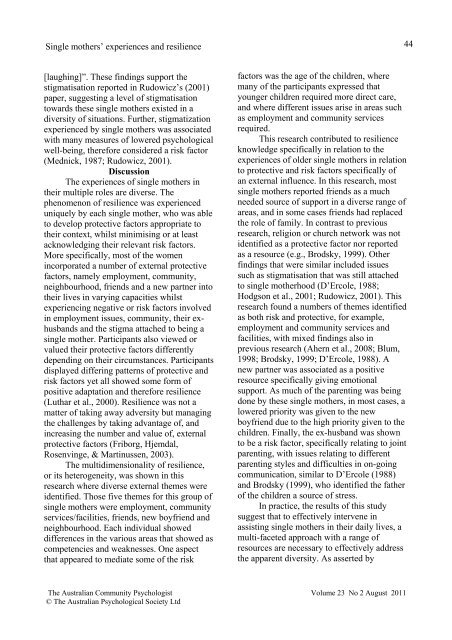The Australian Community Psychologist - APS Member Groups
The Australian Community Psychologist - APS Member Groups
The Australian Community Psychologist - APS Member Groups
Create successful ePaper yourself
Turn your PDF publications into a flip-book with our unique Google optimized e-Paper software.
Single mothers’ experiences and resilience<br />
44<br />
[laughing]”. <strong>The</strong>se findings support the<br />
stigmatisation reported in Rudowicz’s (2001)<br />
paper, suggesting a level of stigmatisation<br />
towards these single mothers existed in a<br />
diversity of situations. Further, stigmatization<br />
experienced by single mothers was associated<br />
with many measures of lowered psychological<br />
well-being, therefore considered a risk factor<br />
(Mednick, 1987; Rudowicz, 2001).<br />
Discussion<br />
<strong>The</strong> experiences of single mothers in<br />
their multiple roles are diverse. <strong>The</strong><br />
phenomenon of resilience was experienced<br />
uniquely by each single mother, who was able<br />
to develop protective factors appropriate to<br />
their context, whilst minimising or at least<br />
acknowledging their relevant risk factors.<br />
More specifically, most of the women<br />
incorporated a number of external protective<br />
factors, namely employment, community,<br />
neighbourhood, friends and a new partner into<br />
their lives in varying capacities whilst<br />
experiencing negative or risk factors involved<br />
in employment issues, community, their exhusbands<br />
and the stigma attached to being a<br />
single mother. Participants also viewed or<br />
valued their protective factors differently<br />
depending on their circumstances. Participants<br />
displayed differing patterns of protective and<br />
risk factors yet all showed some form of<br />
positive adaptation and therefore resilience<br />
(Luthar et al., 2000). Resilience was not a<br />
matter of taking away adversity but managing<br />
the challenges by taking advantage of, and<br />
increasing the number and value of, external<br />
protective factors (Friborg, Hjemdal,<br />
Rosenvinge, & Martinussen, 2003).<br />
<strong>The</strong> multidimensionality of resilience,<br />
or its heterogeneity, was shown in this<br />
research where diverse external themes were<br />
identified. Those five themes for this group of<br />
single mothers were employment, community<br />
services/facilities, friends, new boyfriend and<br />
neighbourhood. Each individual showed<br />
differences in the various areas that showed as<br />
competencies and weaknesses. One aspect<br />
that appeared to mediate some of the risk<br />
factors was the age of the children, where<br />
many of the participants expressed that<br />
younger children required more direct care,<br />
and where different issues arise in areas such<br />
as employment and community services<br />
required.<br />
This research contributed to resilience<br />
knowledge specifically in relation to the<br />
experiences of older single mothers in relation<br />
to protective and risk factors specifically of<br />
an external influence. In this research, most<br />
single mothers reported friends as a much<br />
needed source of support in a diverse range of<br />
areas, and in some cases friends had replaced<br />
the role of family. In contrast to previous<br />
research, religion or church network was not<br />
identified as a protective factor nor reported<br />
as a resource (e.g., Brodsky, 1999). Other<br />
findings that were similar included issues<br />
such as stigmatisation that was still attached<br />
to single motherhood (D’Ercole, 1988;<br />
Hodgson et al., 2001; Rudowicz, 2001). This<br />
research found a numbers of themes identified<br />
as both risk and protective, for example,<br />
employment and community services and<br />
facilities, with mixed findings also in<br />
previous research (Ahern et al., 2008; Blum,<br />
1998; Brodsky, 1999; D’Ercole, 1988). A<br />
new partner was associated as a positive<br />
resource specifically giving emotional<br />
support. As much of the parenting was being<br />
done by these single mothers, in most cases, a<br />
lowered priority was given to the new<br />
boyfriend due to the high priority given to the<br />
children. Finally, the ex-husband was shown<br />
to be a risk factor, specifically relating to joint<br />
parenting, with issues relating to different<br />
parenting styles and difficulties in on-going<br />
communication, similar to D’Ercole (1988)<br />
and Brodsky (1999), who identified the father<br />
of the children a source of stress.<br />
In practice, the results of this study<br />
suggest that to effectively intervene in<br />
assisting single mothers in their daily lives, a<br />
multi-faceted approach with a range of<br />
resources are necessary to effectively address<br />
the apparent diversity. As asserted by<br />
<strong>The</strong> <strong>Australian</strong> <strong>Community</strong> <strong>Psychologist</strong> Volume 23 No 2 August 2011<br />
© <strong>The</strong> <strong>Australian</strong> Psychological Society Ltd

















